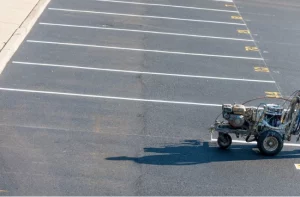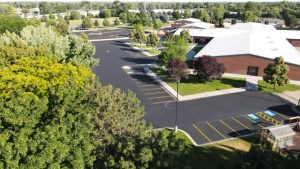The Importance of Prepping Your Area Before Sealcoating
Sealcoating is a crucial part of maintaining and extending the lifespan of your asphalt surface, whether it’s a parking lot, driveway, or roadway. While the sealcoating process itself provides a protective layer against weather, UV damage, and everyday wear and tear, the success of the job heavily depends on how well the surface is prepped beforehand. Proper preparation ensures that the sealcoat adheres correctly, provides long-lasting protection, and delivers a smooth, even finish. Neglecting this important step can lead to premature failure, peeling, or the need for frequent reapplications. Here’s why prepping your area before sealcoating is essential and what it entails.
1. Ensures Proper Adhesion
One of the main reasons to prep the asphalt surface is to ensure that the sealcoat properly adheres to the pavement. For the sealcoat to bond effectively, the surface needs to be clean, smooth, and free of contaminants. Any debris, dirt, or oil left on the surface can create a barrier between the asphalt and the sealcoat, leading to poor adhesion.
- Debris Removal: The first step in prepping is removing all loose materials such as dirt, leaves, gravel, and any other debris. If this isn’t done, the sealcoat will not bond uniformly, causing uneven coverage and reducing the longevity of the coating.
- Oil and Grease Removal: Oil and grease spots are common in parking lots and driveways due to leaking vehicles. These substances prevent the sealcoat from bonding to the asphalt. Special cleaning agents or primers are used to remove or neutralize these areas before applying the sealcoat.
Proper adhesion is critical because it ensures that the sealcoat forms a strong, protective layer that can withstand traffic and environmental elements over time.
2. Prolongs the Life of the Sealcoat
Sealcoating is an investment in the longevity of your asphalt surface, and preparing the area thoroughly helps maximize that investment. When the surface is prepped correctly, the sealcoat can adhere more uniformly and penetrate the asphalt, creating a stronger, more durable barrier. This means fewer cracks, potholes, and other damages down the road, ultimately saving you time and money.
- Crack Repair: Before sealcoating, any cracks in the asphalt need to be filled. If these cracks are left untreated, the sealcoat will not be able to seal the surface properly, allowing water to seep into the pavement. Water infiltration can cause significant damage, leading to further cracking, potholes, and even the breakdown of the subbase. Crackfilling ensures a smooth surface for the sealcoat to bond to and prevents future structural damage.
- Pothole Patching: Like cracks, potholes must be repaired before sealcoating. Sealcoat alone cannot fill deep voids in the pavement, so potholes should be patched with fresh asphalt or other suitable materials before the coating is applied.
By addressing these issues beforehand, you ensure that the sealcoat does its job: protecting your asphalt from the elements and extending its life.
3. Prevents Premature Sealcoat Failure
Skipping or rushing through the preparation process is one of the primary causes of premature sealcoat failure. Without proper prep, the sealcoat may peel, chip, or wear away much sooner than expected, leading to costly reapplications and increased maintenance needs. For the sealcoat to last its full intended lifespan, the area must be properly prepared, including repairing damage, removing contaminants, and ensuring a clean surface.
- Power Washing: Power washing is often used to clean the surface thoroughly, ensuring all dirt, dust, and grime are removed. This step is especially important in high-traffic areas like parking lots, where buildup can be significant.
- Blowing and Sweeping: After the area is power washed, high-powered blowers and sweepers are used to remove any remaining dust and debris from cracks and surface imperfections. This step ensures that the sealcoat will have a smooth, clean surface to adhere to.
Without this level of preparation, the sealcoat may not bond properly, leading to bubbling, peeling, or an uneven finish—all signs of premature sealcoat failure.
4. Improves the Aesthetic Finish
A properly prepped surface not only extends the life of the sealcoat but also improves its appearance. Sealcoating provides a sleek, smooth black finish that makes any asphalt surface look brand new. However, if the surface isn’t prepared correctly, the final result can look uneven, with bumps, cracks, and imperfections still visible through the sealcoat.
- Smoothing the Surface: By repairing cracks and potholes, cleaning the surface thoroughly, and ensuring it is level and free from debris, the sealcoat will have a uniform surface to bond to. This leads to a smoother, more professional-looking finish.
- Enhancing Curb Appeal: A freshly sealcoated and properly prepped parking lot or driveway can significantly enhance the curb appeal of a property. For businesses, this provides a welcoming and well-maintained appearance to customers, which can make a positive impression.
Proper preparation ensures that the sealcoat application looks as good as it performs, delivering both functionality and aesthetics.
5. Saves Time and Money in the Long Run
While proper preparation may seem like an extra step in the process, it ultimately saves both time and money in the long run. When the asphalt surface is prepped correctly, the sealcoat lasts longer, meaning fewer reapplications and repairs are needed over time. Additionally, addressing issues like cracks and potholes before sealcoating prevents more extensive (and expensive) damage down the road.
- Fewer Reapplications: Proper prep helps the sealcoat last its full lifespan, which can be up to three to five years with proper maintenance. Without prep, you may find yourself needing to reapply the sealcoat much sooner, resulting in higher costs over time.
- Reduced Repairs: By addressing cracks, potholes, and other surface issues during the prep stage, you prevent these problems from worsening after the sealcoat is applied. This reduces the need for costly repairs in the future and helps you get the most out of your investment.


